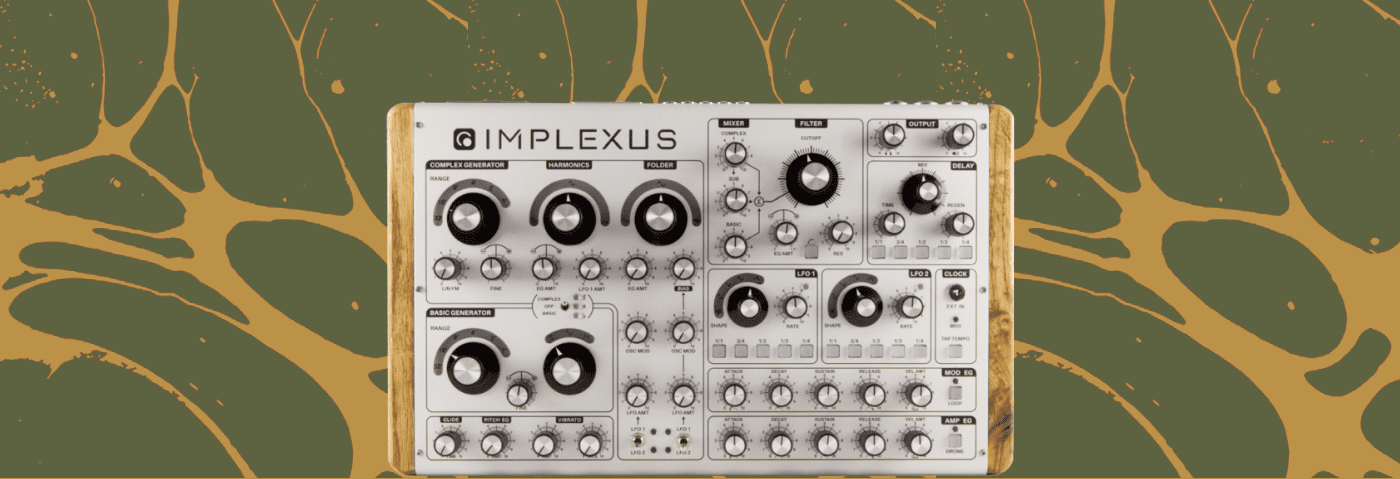Majella Audio have been creating Eurorack modules for the last four years but had already decided to take the larger step of designing a self-contained synthesizer module in 2019. This resulted in a Kickstarter funding campaign in 2020, with its first deliveries being made in 2021. After this initial success, and luckily for us, Implexus is now available via KMR in the UK.
Implexus is a desktop format analogue synthesizer embracing both ‘East Coast’ and ‘West Coast’ synthesis methods. In very basic terms, it is a dual VCO (Voltage Controlled Oscillator) monosynth with an analogue filter, two LFOs (Low-Frequency Oscillators), a pair of envelope generators and stereo digital delay. However, as we shall see, this somewhat undersells the original design remit.
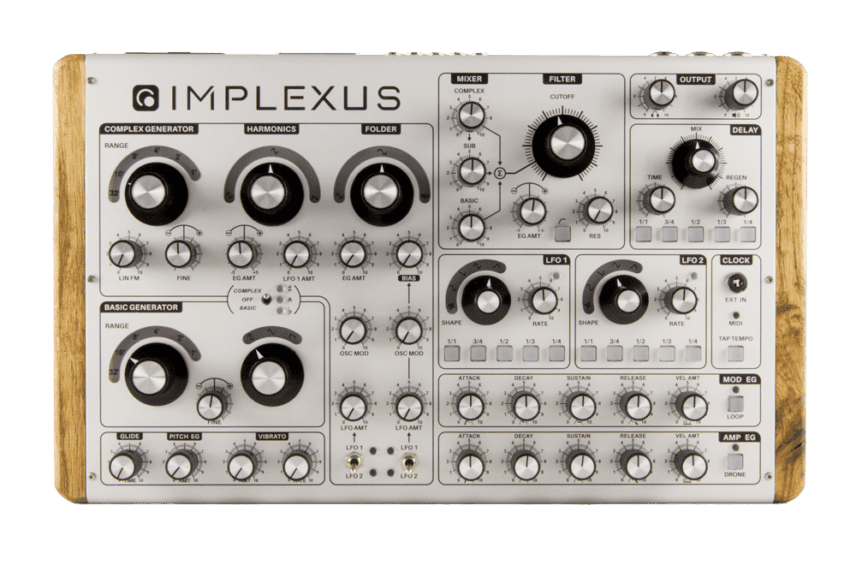
First impressions are of a solid and well-constructed unit that combines steel and wood in a very pleasing way. Knobs and switches feel firm and well-made, with the unit eschewing the more common external power supply for a built-in PSU that connects directly to the mains via a standard C14 IEC connector (and that will work anywhere in the world). Handy!
On the back panel, you’ll also find the expected audio outputs and MIDI connectivity (via DIN and USB), but there are also some clues to Majella’s modular legacy with the cluster of ten 3.5mm mini-jack connectors.
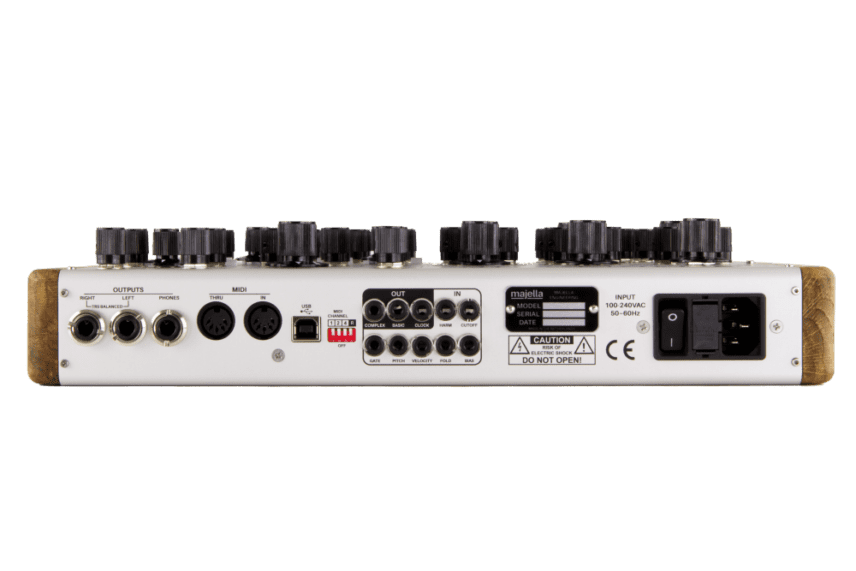
Back on the front panel, you’ll notice that some of the larger knobs have a curved grey strip around their arc of travel, and these serve as a parameter indicator (with some also providing feedback on modulation ranges).
East vs West
Before diving into the minutiae of the Implexus sound engine, it is worth taking a moment to consider what is really meant by the two aforementioned synthesis types sat at opposing ends of the compass. Unlike the famous 90s East Coast–West Coast hip-hop rivalry it is unlikely that anyone suffered harm over beef between the different synth methodologies, but the coarsely-defined alternative approaches taken by synth-designers on each side of the USA in the 1960s are interesting and relevant.
Moog perhaps defines the East Coast approach best described as ‘classic subtractive synthesis’. In other words, you start with a source capable of creating a sound rich in harmonics and then employ low-pass filtering to shape the sound by attenuating those harmonics.
This is commonly done dynamically by using an envelope generator routed to the filter cutoff (though other modulation sources can obviously also be used). It’s also worth noting that Bob Moog was interested in creating instruments that were playable for existing musicians – and therefore employed a conventional keyboard as the initial means of interaction.
In San Francisco, Don Buchla was taking a slightly different path. Like Moog, he developed synth circuits and modules that employed voltage control but instead, the emphasis was more heavily placed on starting with a simpler waveform. Shaping and folding techniques were also used to create something more complex which could be modulated by other audio oscillators to further enhance its harmonic density.
Part of this philosophy was to escape pre-existing musical conventions, which meant that touch plates and other types of interactive elements replaced the ‘musically limiting’ and equally divided 12 semi-tone keyboard.
It is worth stressing that the differences in philosophy did not mean that the two types of synthesis were mutually exclusive – there were, and are, many overlaps between the two. We now, of course, live in a world where it is very easy to employ multiple approaches even if the East Coast way of doing things is perhaps the most familiar.
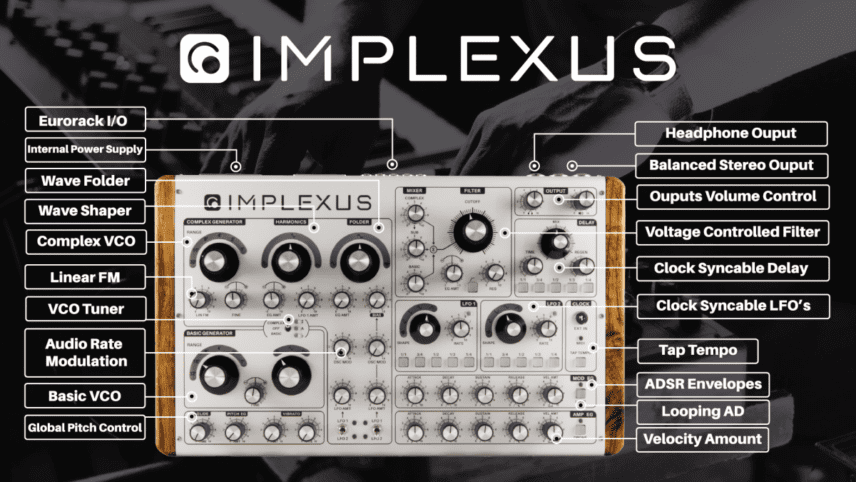
Simple Complexity
Implexus, despite its name (it is Latin for complexity), is a relatively simple synth to get around. Each section is clearly labelled, there is no screen, and no hard-to-remember secondary functions – in other words, what you see is what you get.
The entire left half of the synth is devoted to the oscillators, with the largest functional element being the so-called COMPLEX GENERATOR. As its name suggests, this is devoted to creating a harmonically complex audio output in the West Coast style. This means that the controls might be somewhat unfamiliar to those used to more conventional subtractive synths.
With the Harmonics control at its centre position, this oscillator generates a sine-like pure tone, with clockwise movement adding more even harmonics, and counterclockwise adding odd harmonics (akin to offering square and sawtooth waveforms).
The FOLDER control initially clips the waveform (turning a sine wave more square) beyond half-way then folds the waveform in on itself, emphasising higher harmonics – an effect not dissimilar to tweaking the drawbars on an organ. The smaller BIAS control determines the symmetry (positive vs negative) of this effect, adding further tonal change – especially at the higher settings of the FOLDER knob.
The range of tonal variation here is quite wide but it is with the extra modulation options that things get much more interesting. Before we get into those, let’s look at the BASIC GENERATOR. This again lives up to its name and beside the Range and Fine-tuning controls – also found on the COMPLEX GENERATOR – all it has is a waveform selector to switch between Square, Sine and Sawtooth waveforms.
Having listened further to both oscillators, it became clear that there there was no way to get a pure sine (or close to) out of either – there were always higher harmonics present and audible. Equally the range of the HARMONICS knob in the COMPLEX GENERATOR doesn’t quite get you to the brightness of a “proper” Square wave or fizz of a truer Saw in the BASIC section. The reason for this is due to it being based on Buchla’s oscillators. Wavefolding Sawtooth waveforms would result in a Sine wave, thus defeating the point and making it less versatile.
Mod Cons
Elaborate interaction between the oscillator sections can be created by turning up the LIN FM knob for (frequency modulation), but the HARMONICS control can also be modulated by the MOD EG (envelope generator) or LFO 1 – more on both of these shortly. Equally, wave-folding strength and bias can be modulated independently by the MOD EG, LFO 1 or 2, or basic oscillator (with the addition of EG control over FOLDER amount.

Finally, a global pitch section allows you to add pitch glide between notes (with adjustable glide time), pitch modulation from the MOD EG and VIBRATO with its own rate and depth controls. Being global, all these affect both oscillators equally (which should keep their complex interacting modulations the same regardless of the note being played).
It is also worth noting that the Implexus has an onboard tuner, which allows you to see when either oscillator is at, over or under 440Hz (concert A). This is very helpful when dealing with analogue oscillators whose pitch will drift with changes in temperature.
However, as implemented here, it is reliant on having a MIDI keyboard connected for triggering the appropriate note, which makes you wonder if there might have been a more automated way of achieving this (and in a way that is less reliant on external gear). Nonetheless, this is a useful addition.
Eastern Block
Now we move ‘back East’ where the two oscillators are combined with a square-wave sub-oscillator square wave generator in the mixer section and then fed into the filter. This is a resonant 12dB/octave type, switchable between low and high pass modes, and with the ability to modulate the cutoff frequency via the EG AMT knob.
The filter is decent enough, but it would have been great to have had the ability to push the resonance into self-oscillation and have more modulation sources for influencing cutoff. The addition of a band-pass mode and a noise generator added to the possible mixer inputs would also have been welcome – means further expanding of the unit’s tonal range.
In pure synthesis terms, the aforementioned LFOs and envelope generators (EGs) complete the picture. Both LFOs offer 5 different wave shapes with rates that can be linked to the internal (or MIDI) clock or pushed into the lower part of the audio spectrum for creating odd audio side-band effects.
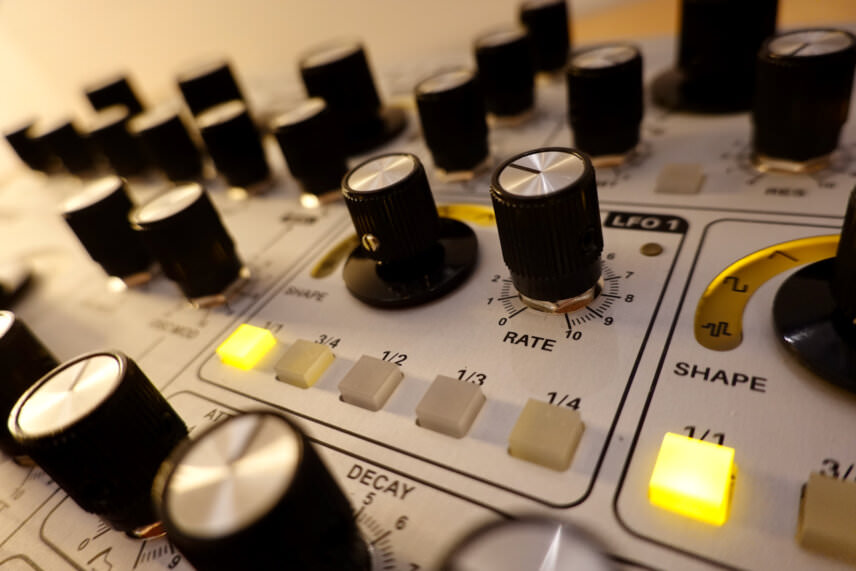
The EGs are both 4-stage types that can respond to incoming MIDI note velocity. The AMP EG is dedicated to loudness contouring (but also offers a useful ‘always open’ drone mode), whilst the general-purpose MOD EG can be turned into a pseudo-LFO by engaging its loop mode.
Finally, sonic finessing is added by the delay line, which has variable time and feedback controls, and adds slight modulation to each channel for a more tape-link effect and with the additional benefit of creating some stereo interest. Like the LFOs, the delay time can be linked to the clock.
The delay is very effective for opening up the sound of the Implexus, though I can’t help but feel that a little more screaming dirt might have been possible at extreme feedback settings.
How does the Implexus sound?
So how does the Implexus sound? Find out for yourself below:
More Or Less
Majella must be admired for trying to do something different in the world of desktop synths – and the Implexus certainly cuts its own path through the fray – but without disregarding MIDI control or ignoring the ability to connect with other analogue gear. The Implexus is currently priced at £1,349, which isn’t too shabby for a synthesiser that features multiple synthesis techniques in a single form factor.
As detailed above, there are some things that I would add or change slightly if I could design Implexus MkII (including adding more options for distortion and gnarliness) but all told, this is an engaging synth to use, with applications ranging from full-on weirdness to more conventional musical tones.
While You’re Here…
If you like this article you might enjoy our book The Secrets of Dance Music Production. It is available from the Attack store!
New customer? Use code ATTACK10WELCOME at checkout for a 10% discount!

